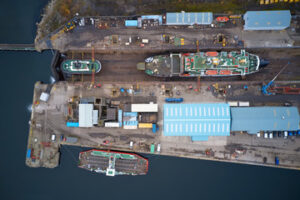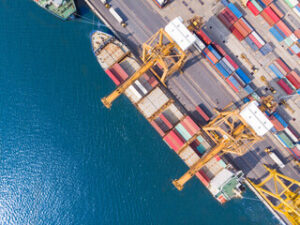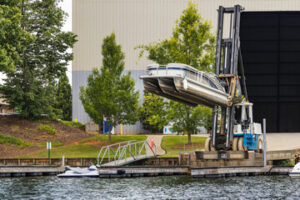Docks are exposed to a lot of damage over time. It is essential to make repairs as soon as possible to prevent more costly damage.

One of the most common problems is wood rot. This is caused by fungus and can be a serious problem for your dock. It is best to replace any rotting areas of your dock with newly treated wood. Click Learn More for more details.
When it comes to dock repair, there are a number of costs associated. These include inspection fees, labor, and materials. The cost of repairing a dock can vary widely, depending on the type of work needed and the materials used. For example, wood repair costs tend to be higher than the cost of repairing aluminum or composite. These factors can make it difficult to predict how much a client will need to spend on repairs.
Inspection fees typically range from $50 to $100. During an inspection, a professional will examine the dock’s various parts, including pilings, railings, and the structure itself. They will look for cracks, rotted sections, and other issues. They may also check the decks, boat lifts, and other structures. After the inspection, they will give the client a full report of their findings and recommendations.
Wood rot is a common problem that affects many docks. It can be caused by a number of things, including fungal growth and exposure to water. When this happens, the wood will rot and eventually crumble. This can cause serious damage to the dock if left untreated. To prevent this, it is important to have a professional inspect your dock on a regular basis and replace any rotting sections as soon as they are found.
Another common problem that can happen to docks is rust. Rust can build up in metal sections of a dock, which can lead to corrosion and other problems. It is important to have a professional inspect your metal dock on a regular basis and repair any problems as soon as they appear.
When estimating the cost of a dock repair, it is important to factor in any associated fees. For example, inspection fees can add up quickly, especially if your dock is large or requires a lot of attention. Likewise, labor fees can be expensive, particularly if the repair is complex or needs to be completed immediately. It is best to consult with a repair specialist to learn about their hourly rate and what types of jobs they specialize in.
Materials
Depending on the type of dock you have, its materials, and your water conditions, there will be different fees and materials needed for repairs. For example, algae build-up on a crib dock in a still pond will cost much less than replacing cables on a suspended dock in a fast-flowing river. Additionally, some dock materials are more resilient than others, so the material of your dock will have a direct impact on repair costs.
Whether your dock is made from wood, aluminum, composite or other materials, it will need to be maintained. For instance, a wood dock that comes in contact with salt water will eventually begin to rot and must be replaced. The same can be said for metal sections of the dock that can begin to rust if left untreated. In addition to rot and rust, your dock’s structure may also become damaged by erosion from the waves or by a boat crashing into it.
When inspecting your dock, it is important to check the condition of all the hardware used to connect the sections together or to other structures. A broken connection can lead to unsafe conditions on the dock, so if it isn’t functioning properly, it should be repaired or replaced immediately.
It is also important to look at the foundation of your dock. If it has become weakened or cracked, it could potentially collapse at the slightest nudge. While some damage to a dock’s foundation may require professional help, many can be easily fixed with a kit that includes concrete, anchors, screws and bolts.
If you want a low-maintenance dock, consider using vinyl planks or another decking material that will not succumb to mildew issues. The most durable types of docks, however, will be those made from aluminum or composite, as these materials are impervious to rot and corrosion. It’s best to enlist the services of a certified and licensed dock installer to ensure that the job is done right. EZ Dock offers a variety of docks in both aluminum and plastic configurations, allowing you to find one that fits your budget and needs.
Inspecting
A dock is a complex structure and requires routine inspections to ensure it functions safely. These inspections will identify issues such as structural damage, weather deterioration and equipment malfunction. By identifying these problems early, they can be repaired quickly and efficiently to extend the life of the dock.
An important part of the inspection process is to examine all components of the dock, including pilings, railings, decking, and boat lifts. The inspector will also look for any signs of rot, warping, discoloration, or other signs of wear and tear. The inspector will then write a detailed report and make recommendations for repairs.
Wood rot is a common problem that can cause serious damage to a dock. It is typically caused by a fungus that grows in the water and attacks the wood. It is often easy to repair by replacing the affected boards with new treated wood.
Another common problem is rust. Rust is a health hazard and can cause serious injury if someone steps on it. It is best to replace rusted parts of a dock as soon as possible to prevent further deterioration.
It is important to inspect the dock regularly, especially after a storm. This will help ensure that the dock is in good condition and that no parts have been damaged or displaced during the storm. It is also important to check for safety hazards, such as cleats that have been pulled loose or nails that are sticking out of boards.
A marine contractor is the best choice for a dock inspection. These professionals will have experience building and repairing docks, so they will be able to spot any potential problems and make repairs. In addition, they can provide a detailed report that will help owners plan for future maintenance and repairs. They can also help owners develop a budget for the entire project. These services are worth the investment because they can save owners money in the long run by preventing expensive repairs. In addition, they can help owners plan for future repairs and make recommendations that will extend the life of their docks.
Repairing
Whether it’s an in-water dock for boat owners or a residential dock that allows people to walk into water from shore, docks experience damage from the environment and normal wear and tear. It’s important to inspect a dock regularly and have any problems repaired immediately, so they don’t get worse.
During the inspection process, a professional will look at different parts of the dock, including the pilings, railings, and decks. They will also check for any rotted sections or other structural problems that require repair. After identifying what needs to be repaired, they will begin the work by waterproofing any replacement planks and posts. This will help to protect the wood from rot and weathering.
Another common repair that is needed for docks is removing and replacing old rusty nails. It is important to remove these nails and rust before they cause further damage to the dock. It is also important to remove any green algae or moss that has grown on the dock to prevent it from becoming more damaged.
Wood rotting is another common problem that can be found in docks. This is usually caused by fungus in the water that causes the wood to decay and crumble over time. Depending on how extensive the rot is, it may be necessary to replace the entire section of the dock. It’s best to replace rotting wooden boards with treated wood, as this will help to keep them in good condition longer.
If the metal sections of a dock are affected by rust, they should be replaced immediately. Rust can cause holes and other structural weaknesses, so it is essential to have these areas repaired as soon as possible. This will ensure that the dock is safe for people to use and will extend its lifespan.
It’s also important to perform regular maintenance on a dock, as this will help to reduce downtime and increase productivity. A routine maintenance program should include minor repairs, cleaning, lubrication, and other activities to keep the dock in good working condition. This will also extend the life of the dock and save on operating costs.

